Differential Evolutionary Mechanisms of Tight Sandstone Reservoirs and Their Influence on Reservoir Quality: A Case Study of Carboniferous–Permian Sandstones in the Shenfu Area, Ordos Basin, China
Abstract
1. Introduction
2. Geological Setting
3. Samples and Methods
4. Results
4.1. Composition of Sandstone
4.1.1. Compositions of Framework
4.1.2. Cements
4.2. Texture of Detrital Grains
4.3. Porosity and Permeability
5. Discussion
5.1. Influence of Composition and Texture on Reservoir Quality
5.2. Influence of Diagenesis on Reservoir Quality
5.2.1. Compaction
5.2.2. Cementation
5.2.3. Dissolution
5.3. Diagenetic History
5.3.1. Eodiagenesis
5.3.2. Mesodiagenesis
6. Conclusions
Author Contributions
Funding
Data Availability Statement
Conflicts of Interest
References
- Song, F.; Kong, Q.Y.; Su, N.N.; Jiao, G.H.; Xu, M.M. Formation mechanism of the upper Paleozoic tight sandstone gas reservoir in the Daniudi gas field, Ordos Basin, China. Front. Earth Sci. 2024, 12, 1355494. [Google Scholar] [CrossRef]
- Wang, Z.Y.; Zhou, N.W.; Lu, S.F.; Liu, Y.C.; Lin, L.M.; Liu, Y.; Song, B. Generation, accumulation, and distribution of Upper Paleozoic tight sandstone gas in the northeastern margin of the Ordos Basin. Mar. Pet. Geol. 2023, 156, 106463. [Google Scholar] [CrossRef]
- Wang, M.H.; Sung, M.; Cao, C.; Xue, H.F.; Zhang, Q.; Yang, L.B.; Wang, W. Optimization of fracturing fluid system and fracturing technology in tight sandstone reservoirs. Fresenius Environ. Bull. 2021, 30, 9237–9243. [Google Scholar]
- Li, Y.; Gao, X.D.; Meng, S.Z.; Wu, P.; Niu, X.L.; Qiao, P.; Elsworth, D. Diagenetic sequences of continuously deposited tight sandstones in various environments: A case study from upper Paleozoic sandstones in the Linxing area, eastern Ordos basin, China. AAPG Bull. 2019, 103, 2757–2783. [Google Scholar] [CrossRef]
- Chen, J.Y.; Zhang, H.W.; Chang, H.L.; Wang, Q.W. Research on main controlling factors of tight sandstone gas accumulation in coal-bearing strata in the southern North China Basin: Comparison with the Ordos Basin. Front. Earth Sci. 2023, 10, 1037658. [Google Scholar] [CrossRef]
- Lan, C.L.; Yang, M.H.; Zhang, Y.Z. Impact of sequence stratigraphy, depositional facies and diagenesis on reservoir quality: A case study on the Pennsylvanian Taiyuan sandstones, northeastern Ordos Basin, China. Mar. Pet. Geol. 2016, 69, 216–230. [Google Scholar] [CrossRef]
- Liu, J.L.; Liu, K.Y.; Huang, X. Effect of sedimentary heterogeneities on hydrocarbon accumulations in the Permian Shanxi Formation, Ordos Basin, China: Insight from an integrated stratigraphic forward and petroleum system modelling. Mar. Pet. Geol. 2016, 76, 412–431. [Google Scholar] [CrossRef]
- Su, N.N.; Song, F.; Qiu, L.W.; Zhang, W. Diagenetic evolution and densification mechanism of the Upper Paleozoic tight sandstones in the Ordos Basin, Northern China. J. Asian Earth Sci. 2021, 205, 104613. [Google Scholar] [CrossRef]
- Yang, H.; Fu, J.H.; Liu, X.S.; Meng, P.L. Accumulation conditions and exploration and development of tight gas in the Upper Paleozoic of the Ordos Basin. Pet. Explor. Dev. 2012, 39, 315–324. [Google Scholar] [CrossRef]
- Gao, X.D.; Wang, Y.B.; Li, Y.; Guo, H.; Ni, X.M.; Wu, X.; Zhao, S.H. Characteristics of tight sandstone reservoirs and controls of reservoir quality: A case study of He 8 sandstones in the Linxing area, eastern ordos basin, China. Acta Geol. Sin.-Engl. Ed. 2019, 93, 637–659. [Google Scholar] [CrossRef]
- Cao, B.F.; Luo, X.R.; Worden, R.H.; Wang, X.Z.; He, Y.H.; Qiao, X.Y.; Zhang, L.K.; Lei, Y.H.; Zhou, J.S.; Deng, C. Contrasting diagenetic evolution and hydrocarbon charge of tight gas sandstones in the lower Permian Shanxi Formation, southeastern Ordos Basin, China. J. Asian Earth Sci. 2024, 276, 106330. [Google Scholar] [CrossRef]
- Ding, X.; Yang, P.; Han, M.; Chen, Y.; Zhang, S.; Zhang, S.; Liu, X.; Gong, Y.; Nechval, A.M. Characteristics of gas accumulation in a less efficient tight-gas reservoir, He 8 interval, Sulige gas field, Ordos Basin. Russ. Geol. Geophys. 2016, 57, 1064–1077. [Google Scholar] [CrossRef]
- Wang, S.M. Tectonic evolution and tectonic coal control in Ordos Basin. Geol. Bull. China 2011, 30, 544–552. [Google Scholar]
- Dou, W.C.; Liu, L.F.; Wu, K.J.; Xu, Z.J.; Feng, X. Origin and significance of secondary porosity: A case study of upper Triassic tight sandstones of Yanchang Formation in Ordos Basin, China. J. Pet. Sci. Eng. 2017, 149, 485–496. [Google Scholar] [CrossRef]
- Guo, Y.Q.; Li, B.Q.; Li, B.; Li, W.H.; Cao, H.X.; Liao, X.; Wu, Z.Z.; Fei, S.X.; Zhang, Q.; Chen, Q.; et al. Sedimentary system and palaeogeographic evolution of Ordos Basin, northern China. J Palaeogeogr. 2025, 14, 501–534. [Google Scholar] [CrossRef]
- Anees, A.; Zhang, H.; Ashraf, U.; Wang, R.; Liu, K.; Abbas, A.; Ullah, Z.; Zhang, X.N.; Duan, L.Z.; Liu, F.W.; et al. Sedimentary facies controls for reservoir quality prediction of XiaShihezi member-1 of the Hangjinqi area, Ordos Basin. Minerals 2022, 12, 126. [Google Scholar] [CrossRef]
- Ran, X.; Fu, J.; Wei, X.; Ren, J.; Sun, L.; Bao, H. Evolution of the Ordovician top boundary and its relationship to reservoirs’ development, Ordos Basin. Pet. Explor. Dev. 2012, 39, 165–172. [Google Scholar] [CrossRef]
- Li, P.; Zheng, M.; Bi, H.; Wu, S.T.; Wang, X.R. Pore throat structure and fractal characteristics of tight oil sandstone: A case study in the Ordos Basin, China. J. Pet. Sci. Eng. 2017, 149, 665–674. [Google Scholar] [CrossRef]
- Liu, C.Y.; Zhao, H.G.; Sun, Y.Z. Tectonic background of Ordos Basin and its controlling role for basin evolution and energy mineral deposits. Energy Explor. Exploit. 2009, 27, 15–27. [Google Scholar] [CrossRef]
- Wu, P.; Wu, J.G.; Xu, W.K.; Deng, J.M.; Ju, Y.W. Nanopore Structure Distribution of the Upper Paleozoic Tight Sandstones and Its Controls on Gas Production Performance in the Shenfu Area, Northeastern Ordos Basin, China. J. Nanosci. Nanotechnol. 2021, 21, 98–107. [Google Scholar] [CrossRef] [PubMed]
- Wang, C.W.; Jia, C.S.; Peng, X.L.; Chen, Z.X.; Zhu, S.Y.; Sun, H.S.; Zhang, J. Effects of wellbore interference on concurrent gas production from multilayered tight sands: A case study in eastern Ordos Basin, China. J. Pet. Sci. Eng. 2019, 179, 707–715. [Google Scholar] [CrossRef]
- Zhao, Z.F.; Pang, X.Q.; Jiang, F.J.; Wang, K.; Li, L.; Zhang, K.; Zheng, X.W. Hydrocarbon generation from confined pyrolysis of lower Permian Shanxi Formation coal and coal measure mudstone in the Shenfu area, northeastern Ordos Basin, China. Mar. Pet. Geol. 2018, 97, 355–369. [Google Scholar] [CrossRef]
- Ajdukiewicz, J.M.; Lander, R.H. Sandstone reservoir quality prediction: The state of the art. AAPG Bull. 2010, 94, 1083–1091. [Google Scholar] [CrossRef]
- Taylor, T.R.; Giles, M.R.; Hathon, L.A.; Diggs, T.N.; Braunsdorf, N.R.; Birbiglia, G.V.; Kittridge, M.G.; Macaulay, C.L.; Espejo, I.S. Sandstone diagenesis and reservoir quality prediction: Models, myths, and reality. AAPG Bull. 2010, 94, 1093–1132. [Google Scholar] [CrossRef]
- Lai, J.; Wang, G.W.; Chai, Y.; Wu, Q.K.; Zhang, X.T.; Sun, Y.H. Deep burial diagenesis and reservoir quality evolution of high-temperature, high-pressure sandstones: Examples from Lower Cretaceous Bashijiqike Formation in Keshen area, Kuqa depression, Tarim basin of China. AAPG Bull. 2017, 101, 829–862. [Google Scholar] [CrossRef]
- Chen, Y.H.; Wang, Y.B.; Guo, M.Q.; Wu, H.Y.; Li, J.; Wu, W.T.; Zhao, J.Z. Differential enrichment mechanism of organic matters in the marine-continental transitional shale in northeastern Ordos Basin, China: Control of sedimentary environments. J. Nat. Gas Sci. Eng. 2020, 83, 103625. [Google Scholar] [CrossRef]
- He, Q.Y.; Li, D.L.; Sun, Q.; Gao, J.W.; Li, H.B.; Li, X.H.; Zhao, X.C.; Wang, S.F.; Ji, G.Z. Constraints of palaeoenvironment on organic matter of Benxi Formation shale and discussion on enrichment mechanism under different facies. Frontiers of Earth Science 2023, 18, 148–171. [Google Scholar] [CrossRef]
- Jiu, B.; Huang, W.H.; Li, Y.; He, M.Q. Influence of clay minerals and cementation on pore throat of tight sandstone gas reservoir in the eastern Ordos Basin, China. J. Nat. Gas Sci. Eng. 2021, 87, 103762. [Google Scholar] [CrossRef]
- Li, M.P.; Shao, L.Y.; Dong, D.X.; Lu, J.; Li, J.Q. Clay mineral characteristics and its geological significance in argillaceous rock in eastern margin of Ordos basin. Coal Geol. Explor. 2017, 45, 39–44. [Google Scholar] [CrossRef]
- Wang, R.; Shi, W.Z.; Xie, X.Y.; Zhang, W.; Qin, S.; Liu, K.; Busbey, A.B. Clay mineral content, type, and their effects on pore throat structure and reservoir properties: Insight from the Permian tight sandstones in the Hangjinqi area, north Ordos Basin, China. Mar. Pet. Geol. 2020, 115, 104281. [Google Scholar] [CrossRef]
- Cao, Z.; Liu, G.D.; Meng, W.; Wang, P.; Yang, C.Y. Origin of different chlorite occurrences and their effects on tight clastic reservoir porosity. J. Pet. Sci. Eng. 2017, 160, 384–392. [Google Scholar] [CrossRef]
- Xu, N.N.; Qiu, L.W.; Eriksson, K.A.; Klyukin, Y.I.; Wang, Y.; Yang, Y.Q. Influence of detrital composition on the diagenetic history of tight sandstones with implications for reservoir quality: Examples from the Permian Xiashihezi Formation and Carboniferous Taiyuan Formation, Daniudi gas field, Ordos Basin, China. Mar. Pet. Geol. 2017, 88, 756–784. [Google Scholar] [CrossRef]
- Zhang, H.; Jiang, X.W.; Wan, L.; Ke, S.; Liu, S.A.; Han, G.L.; Guo, H.M.; Dong, A.G. Fractionation of Mg isotopes by clay formation and calcite precipitation in groundwater with long residence times in a sandstone aquifer, Ordos Basin, China. Geochim. Cosmochim. Acta 2018, 237, 261–274. [Google Scholar] [CrossRef]
- Zhu, S.F.; Wang, X.X.; Qin, Y.; Jia, Y.; Zhu, X.M.; Zhang, J.T.; Hu, Y.Q. Occurrence and origin of pore-lining chlorite and its effectiveness on preserving porosity in sandstone of the middle Yanchang Formation in the southwest Ordos Basin. Appl. Clay Sci. 2017, 148, 25–38. [Google Scholar] [CrossRef]
- Huang, S.J.; Huang, K.K.; Feng, W.L.; Tong, H.P.; Liu, L.H.; Zhang, X.H. Mass exchanges among feldspar, kaolinite and illite and their influences on secondary porosity formation in clastic diagenesis A case study on the Upper Paleozoic, Ordos Basin and Xuiiahe Formation, Western Sichuan Depression. Geochimica 2009, 38, 498–506. [Google Scholar] [CrossRef]
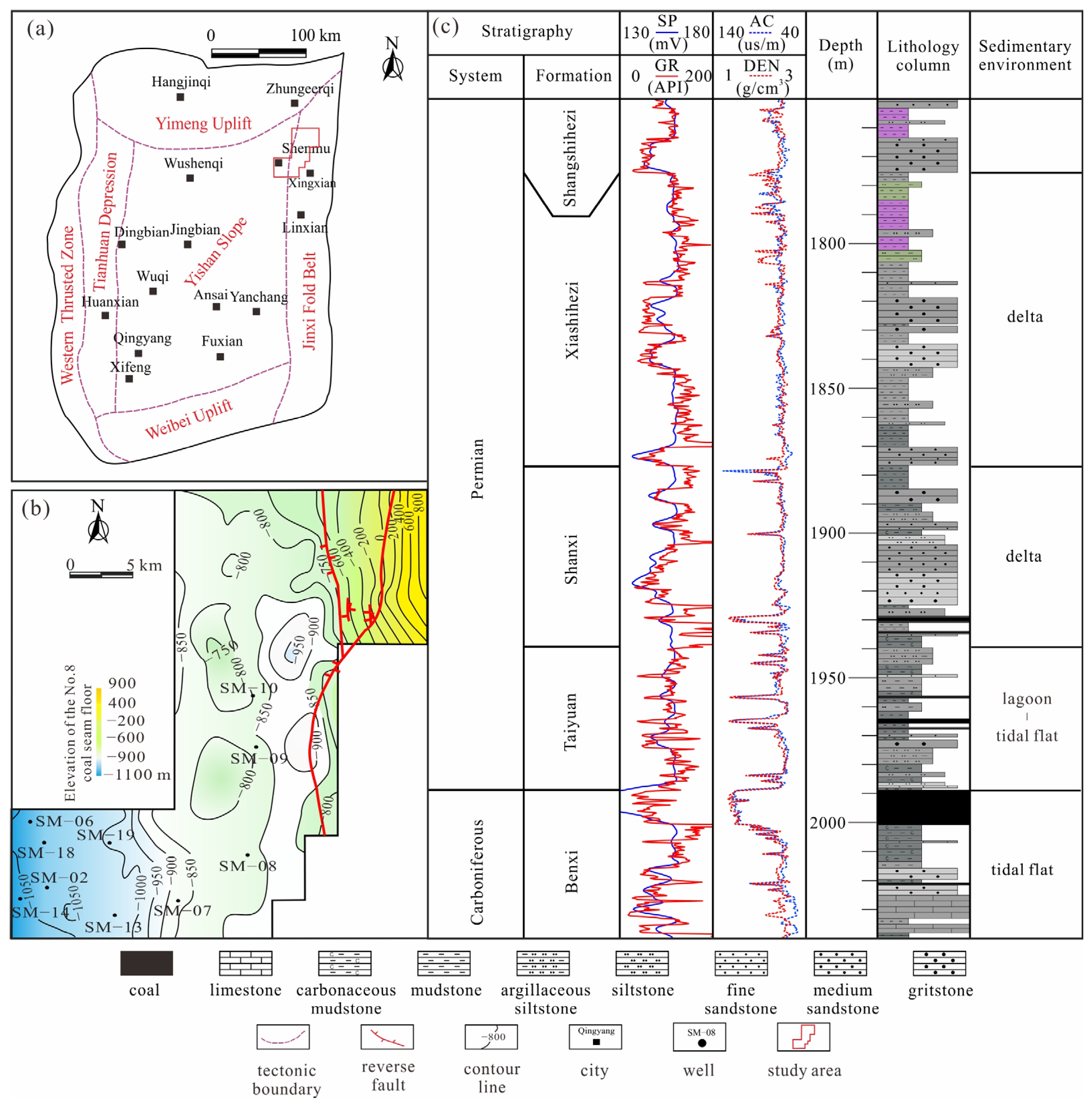
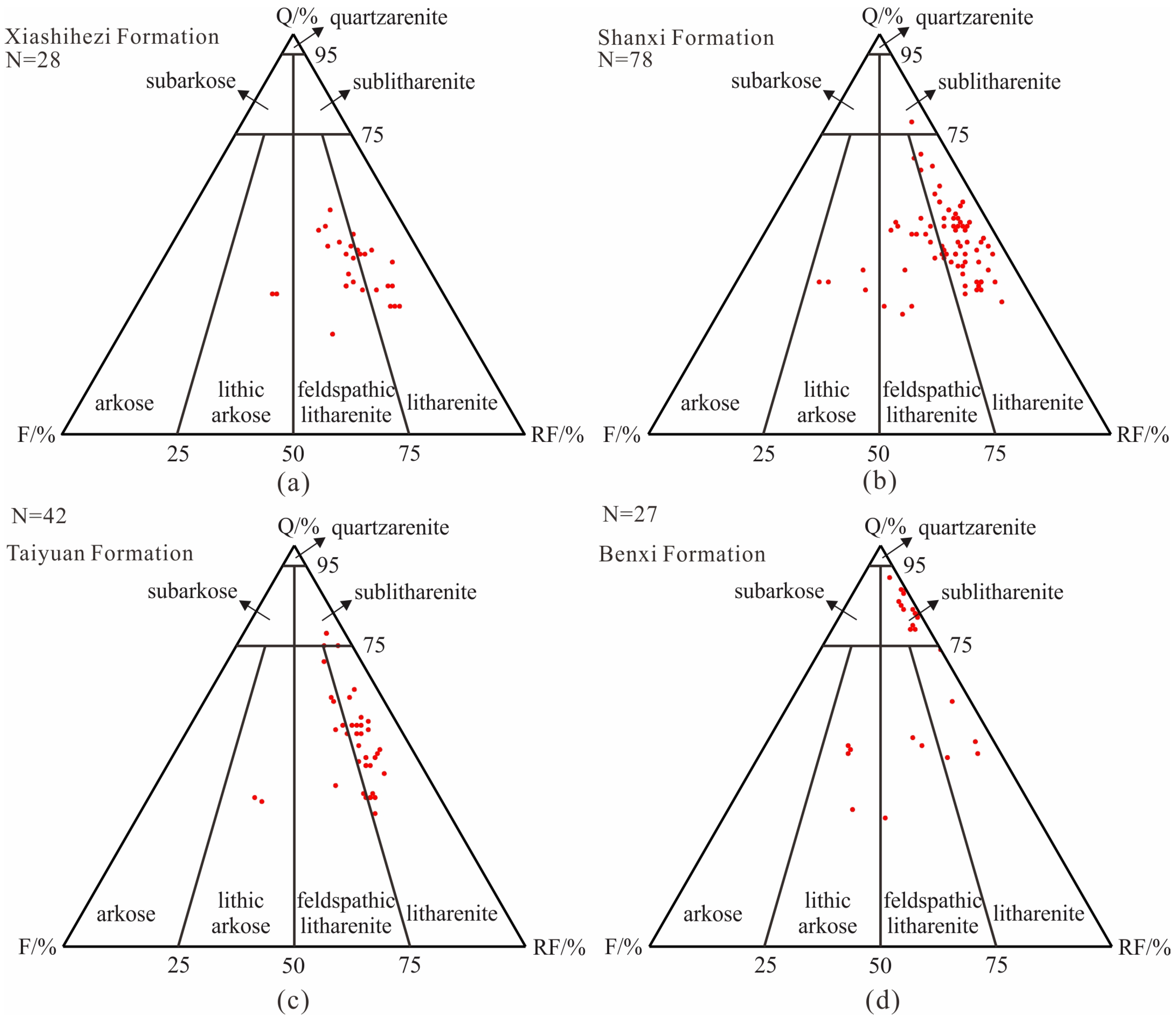

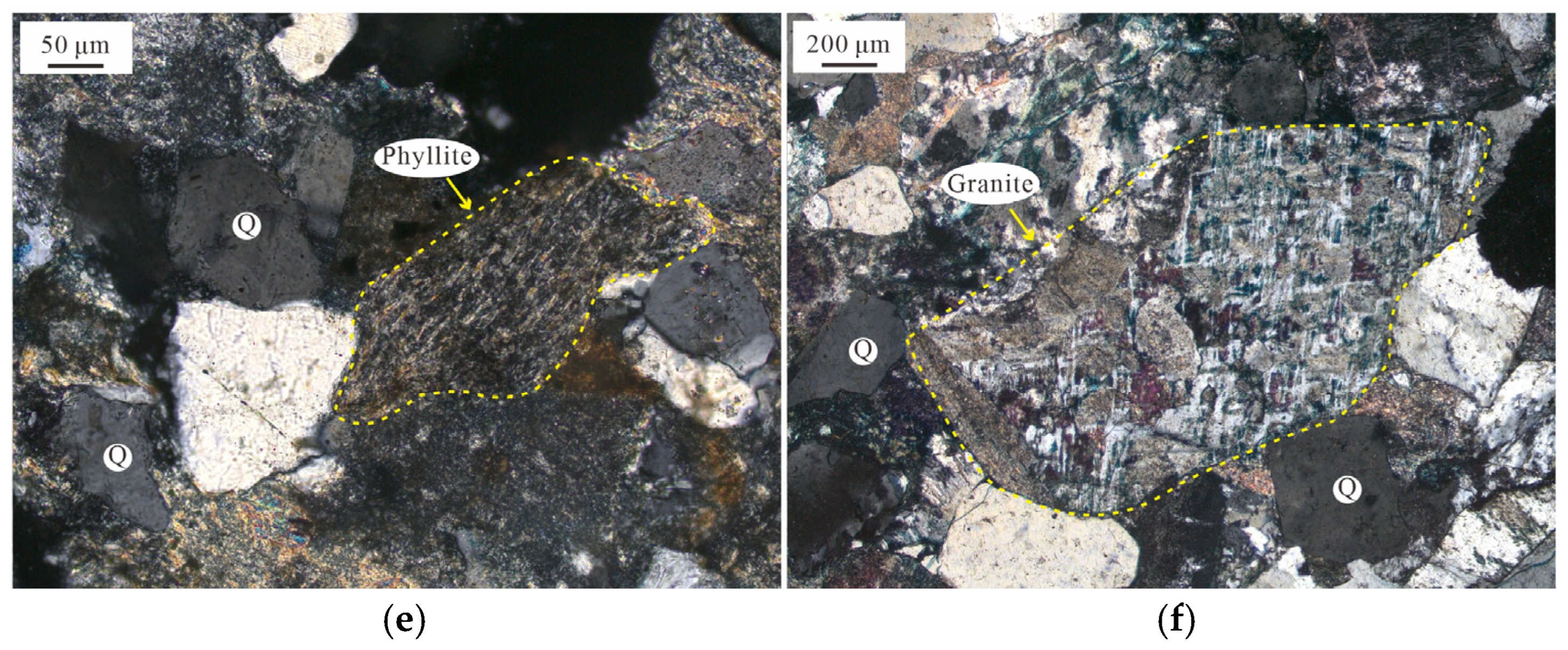


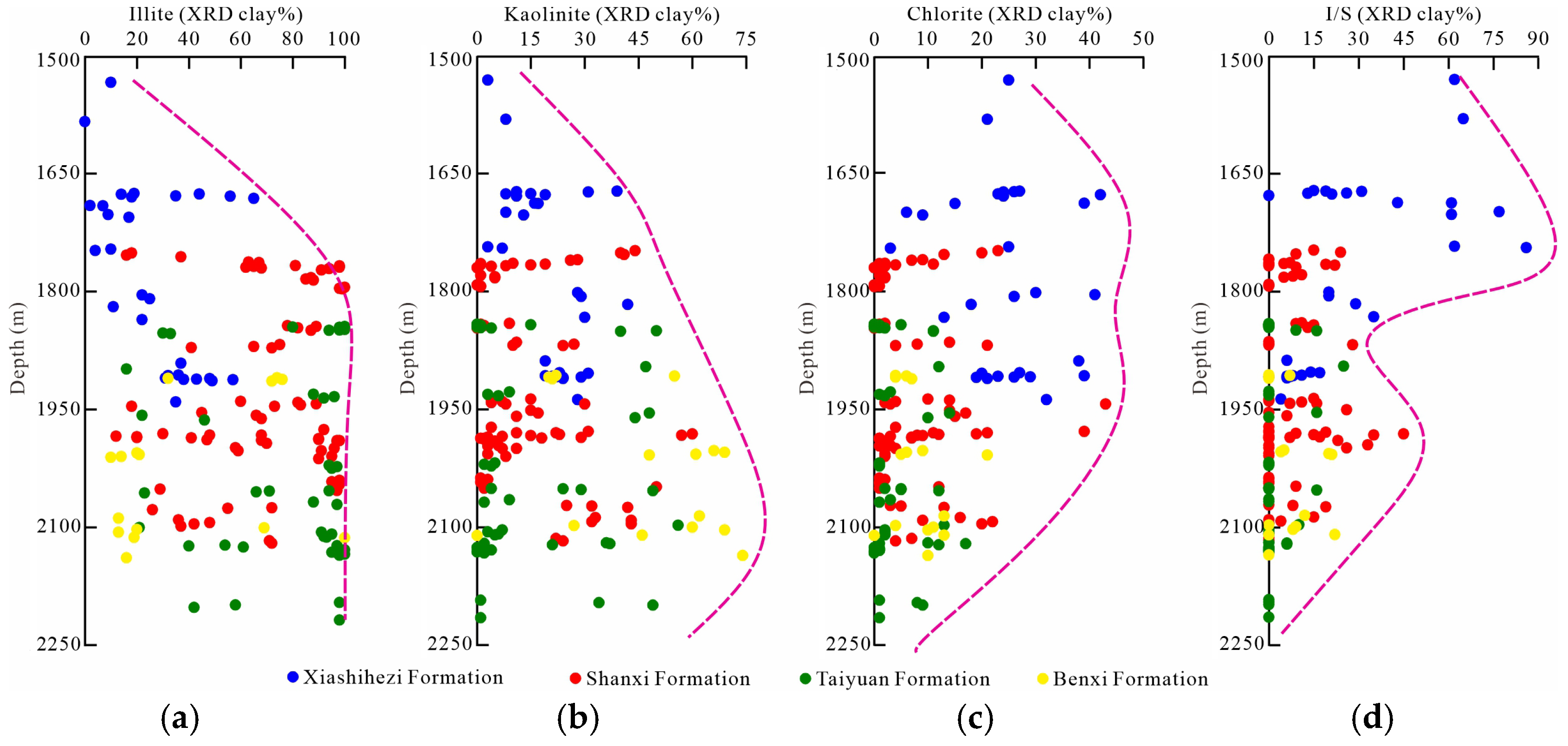






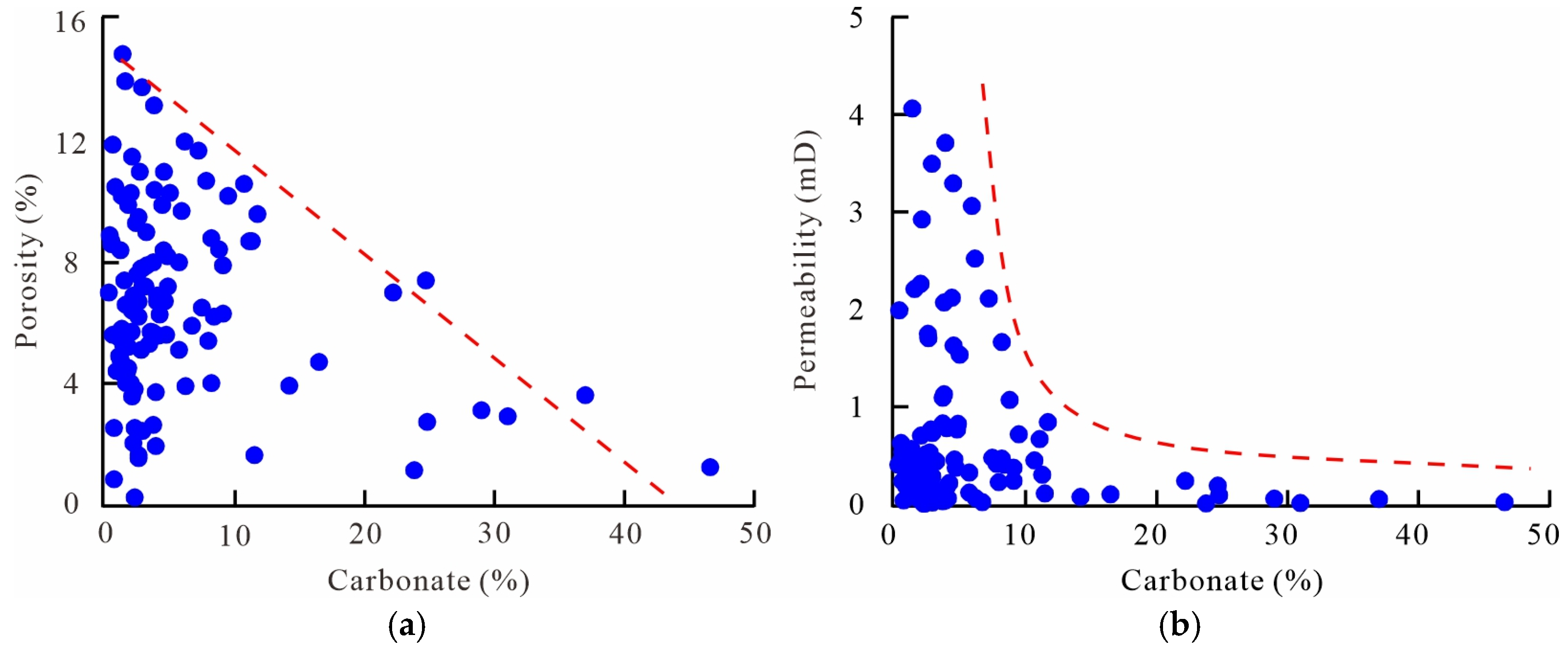
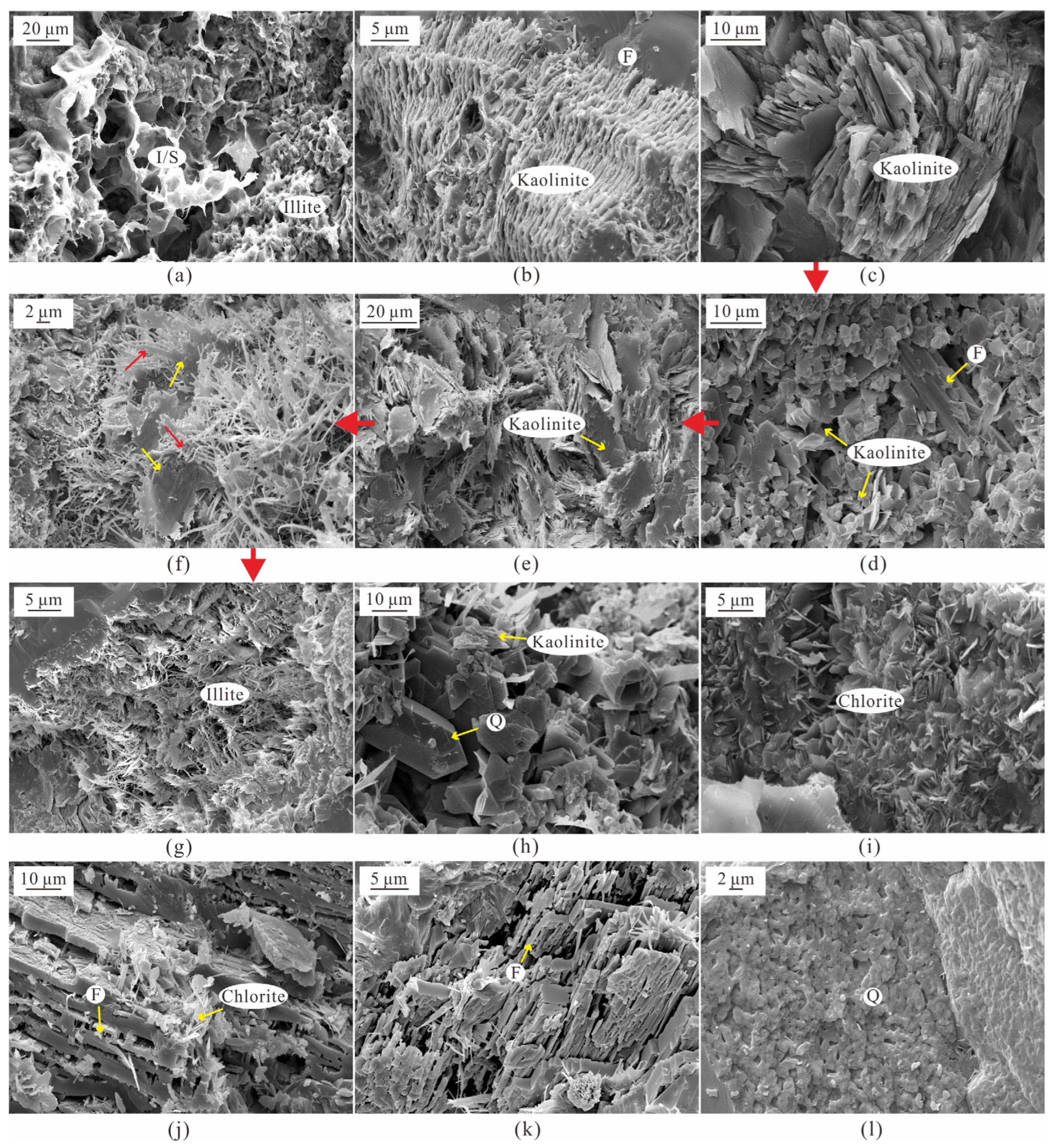
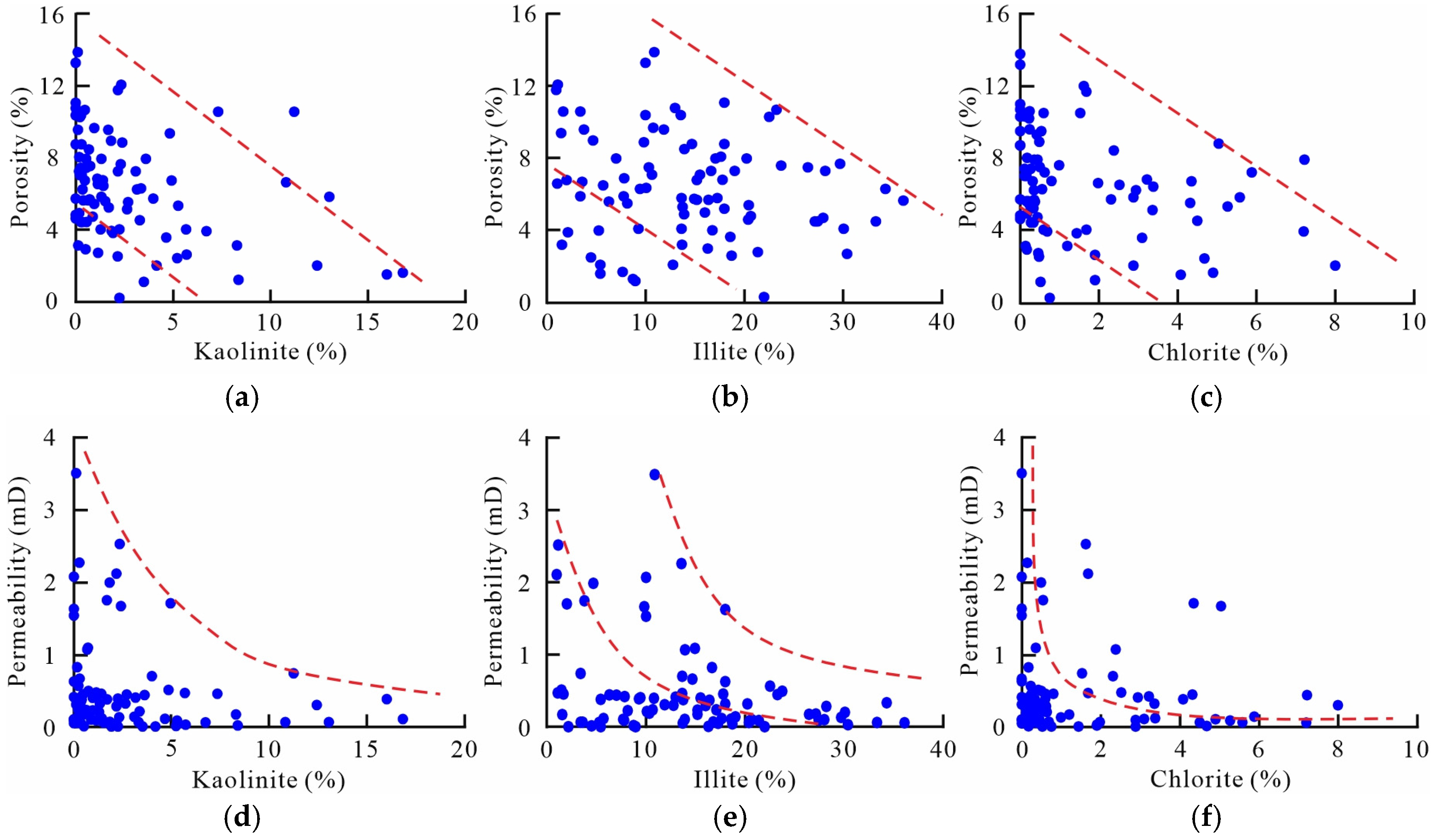

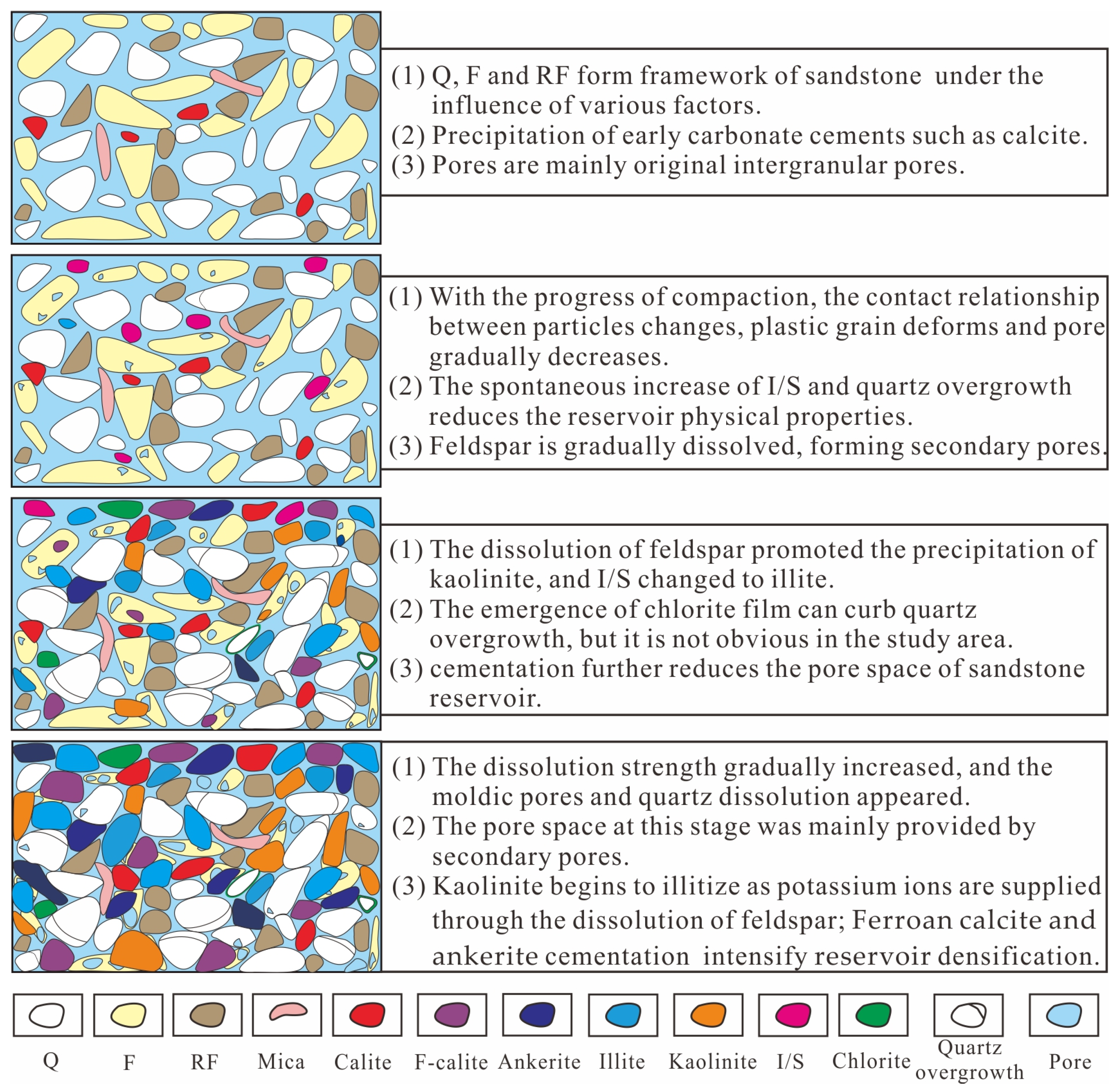
Disclaimer/Publisher’s Note: The statements, opinions and data contained in all publications are solely those of the individual author(s) and contributor(s) and not of MDPI and/or the editor(s). MDPI and/or the editor(s) disclaim responsibility for any injury to people or property resulting from any ideas, methods, instructions or products referred to in the content. |
© 2025 by the authors. Licensee MDPI, Basel, Switzerland. This article is an open access article distributed under the terms and conditions of the Creative Commons Attribution (CC BY) license (https://creativecommons.org/licenses/by/4.0/).
Share and Cite
Gao, X.; Guo, Y.; Guo, H.; Sun, H.; Wu, X.; Zhang, M.; Liu, X.; Deng, J. Differential Evolutionary Mechanisms of Tight Sandstone Reservoirs and Their Influence on Reservoir Quality: A Case Study of Carboniferous–Permian Sandstones in the Shenfu Area, Ordos Basin, China. Minerals 2025, 15, 744. https://doi.org/10.3390/min15070744
Gao X, Guo Y, Guo H, Sun H, Wu X, Zhang M, Liu X, Deng J. Differential Evolutionary Mechanisms of Tight Sandstone Reservoirs and Their Influence on Reservoir Quality: A Case Study of Carboniferous–Permian Sandstones in the Shenfu Area, Ordos Basin, China. Minerals. 2025; 15(7):744. https://doi.org/10.3390/min15070744
Chicago/Turabian StyleGao, Xiangdong, You Guo, Hui Guo, Hao Sun, Xiang Wu, Mingda Zhang, Xirui Liu, and Jiawen Deng. 2025. "Differential Evolutionary Mechanisms of Tight Sandstone Reservoirs and Their Influence on Reservoir Quality: A Case Study of Carboniferous–Permian Sandstones in the Shenfu Area, Ordos Basin, China" Minerals 15, no. 7: 744. https://doi.org/10.3390/min15070744
APA StyleGao, X., Guo, Y., Guo, H., Sun, H., Wu, X., Zhang, M., Liu, X., & Deng, J. (2025). Differential Evolutionary Mechanisms of Tight Sandstone Reservoirs and Their Influence on Reservoir Quality: A Case Study of Carboniferous–Permian Sandstones in the Shenfu Area, Ordos Basin, China. Minerals, 15(7), 744. https://doi.org/10.3390/min15070744





